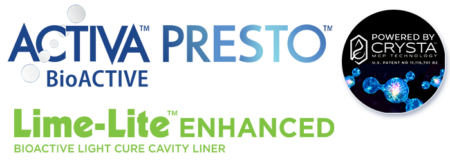Introducing Crysta
Newly Patented MCP Technology for the
Next Generation of Dental Materials

Pulpdent awarded two patents for stabilized calcium phosphate molecule
Press Release: January 10, 2022
Novel methacrylate-functionalized calcium phosphate component in dentistry
Polymers Journal Article
Newly patented Crysta molecule powers ACTIVA Presto, Pulpdent’s latest bioactive restorative
Press Release: January 10, 2022
Crysta shatters the ceiling for dental materials, erasing the line between preventive and restorative dentistry
Dentists can now use bio-interactive restorative materials that remineralize teeth and facilitate hydroxyapatite—without compromising esthetics. Crysta is form and function working as one.

Immediately available in Pulpdent restorative products, including Activa Presto universal light-cure composite and Lime-Lite Enhanced cavity liner
CRYSTA MCP TECHNOLOGY EXPLAINED
Need something else? Contact us.
Below: SEM micrographs and EDS of specimens containing 3 wt.% Crysta MCP technology before and after immersion in PBS for 21 days. Click the image to see the figure in a recent article in Polymers.
Crysta Q&A
What is Crysta?
Crysta is the trade name for a newly patented bio-interactive molecule from Pulpdent, a dental research and manufacturing company founded in 1947 and based in Watertown, Massachusetts. Crysta is not a product, but rather a proprietary technology that can be employed in dental materials. The technical name for the Crysta molecule is “methacrylate-functionalized calcium phosphate”—or “MCP” for short. It is a stabilized calcium phosphate that is arrested in a transitional state, and able to provide needed calcium, phosphate, and fluoride to damaged teeth. Pulpdent established a new category of esthetic, durable, bioactive composite materials with the introduction of its ACTIVA BioACTIVE product line in 2013. The Crysta discovery widens the possibilities for “smart” dental materials. It accelerates dentistry’s movement away from passive materials and toward active restoratives as the universally recognized standard of care.
Why is Crysta important to me as a dentist?
Crysta is a leap in dental material science that erases the line between restorative and preventive dentistry. Consider the current divergent models of dental treatment. One model relies on inert materials (e.g., amalgam and traditional composites) to treat dental problems, while the other employs “smart” or “bioactive” materials that dynamically interact with saliva and teeth to promote dental health. Crysta MCP technology falls into the latter category. Crysta can be incorporated in esthetic, load-bearing composites to facilitate remineralization of tooth structure, seal margins through deposition of calcium, phosphate, and fluoride, and break the cycle of restorative failure and secondary caries. In short, Crysta shatters the ceiling for restorative dentistry. It links restorative procedures with prevention and sets a new standard for form and function working together in dentistry.
Is Crysta available in products now?
Yes. Crysta is currently a component of three Pulpdent products: ACTIVA Presto, ACTIVA Pronto, and Lime-Lite Enhanced. Pulpdent is researching the potential for incorporating Crysta in future products, such as packable composites, bonding agents, orthodontic bracket adhesives, root canal sealers, and cements.
What is Crysta’s mechanism of action?
One way to understand Crysta is that it is essentially calcium-deficient hydroxyapatite. It is searching for calcium. That calcium can be found in saliva and in teeth. However, Crysta doesn’t remove calcium from the teeth; rather it binds to calcium on the teeth. Crysta also acts as a precursor for nucleation sites that attract and bind to calcium and phosphate in the environment, simulating the slow, natural process of mineralization. In cariogenic conditions (pH ≤ 5), Crysta-containing materials can release calcium and phosphate, and they can recharge as the pH approaches neutral.
Is Crysta a filler?
Crysta is synthesized in powder form; however, when incorporated into a dental composite resin, Crysta is not a traditional filler and does not exist as discrete particles. Instead, it dissolves and becomes part of the resin phase. When cured, the composite exhibits low solubility and low water sorption. In the presence of water or saliva, however, the cured resin becomes an active ionic system. It releases and recharges calcium, phosphate, and fluoride, and serves as the scaffolding for mineral deposits on the composite surface and along the material-tooth interface.
Is Crysta backed by research?
There are scientific publications documenting the mechanical and bioactive properties of Crysta MCP and materials containing varying concentrations of MCP. These include:
- United States Patent: US 2016/0256362 A1; Stabilized Calcium Phosphate and Methods of Forming Same;
- United States Patent: US 11,116,701 B2: Stabilized Calcium Phosphate;
- Skaria S, Berk KJ. Experimental dental composites containing a novel methacrylate-functionalized calcium phosphate component: evaluation of bioactivity and physical properties. Polymers 2021;11(13):2095;
- Ames K. Method for detecting calcium phosphate mineralization on dental composites. Academy of Dental Materials 2021.
Does Crysta replace previous bioactive technologies?
No. The remarkable thing about products containing Crysta MCP is that they work with other bioactive materials as well as traditional materials. Think of Crysta as a new tool that fundamentally expands the dentists’ palette of “smart” restorative options.
Where can I find out more about Crysta or use products with this technology?
To talk to a regional representative from Pulpdent about Crysta, Activa Presto, Activa Pronto, or Lime-Lite Enhanced email smarketing@pulpdent.com. To stay informed about educational opportunities, including future CE webinars on this topic, subscribe to the monthly Pulpdent newsletter. To learn about ACTIVA Presto, visit this page, and to learn about Lime-Lite Enhanced, visit this page. Products may be purchased through pulpdent.com or by contacting your preferred dental dealer.
ADDITIONAL INFO ON CRYSTA
ABOUT PULPDENT
PULPDENT IS A GLOBAL COMPANY BASED IN WATERTOWN, MASSACHUSETTS, USA, THAT FOCUSES ON ORIGINAL DENTAL RESEARCH AND CONDUCTS START-TO-FINISH, ON-SITE DOMESTIC MANUFACTURING. INNOVATION, DEDICATION, AND EMPOWERMENT ARE ITS DRIVING VALUES. PULPDENT PIONEERED BIOACTIVE DENTAL MATERIALS AND TODAY IS A MARKET LEADER. IN 2021 PULPDENT ACHIEVED 100% BPA-FREE DENTAL RESTORATIVE MATERIALS.
IN 2022, CELEBRATE 75 YEARS WITH US AS WE SET A NEW VISION FOR DENTISTRY
#pulpdent75 | @pulpdent | @pulpdentcorporation
SETTING A NEW VISION FOR THE FUTURE OF DENTISTRY













